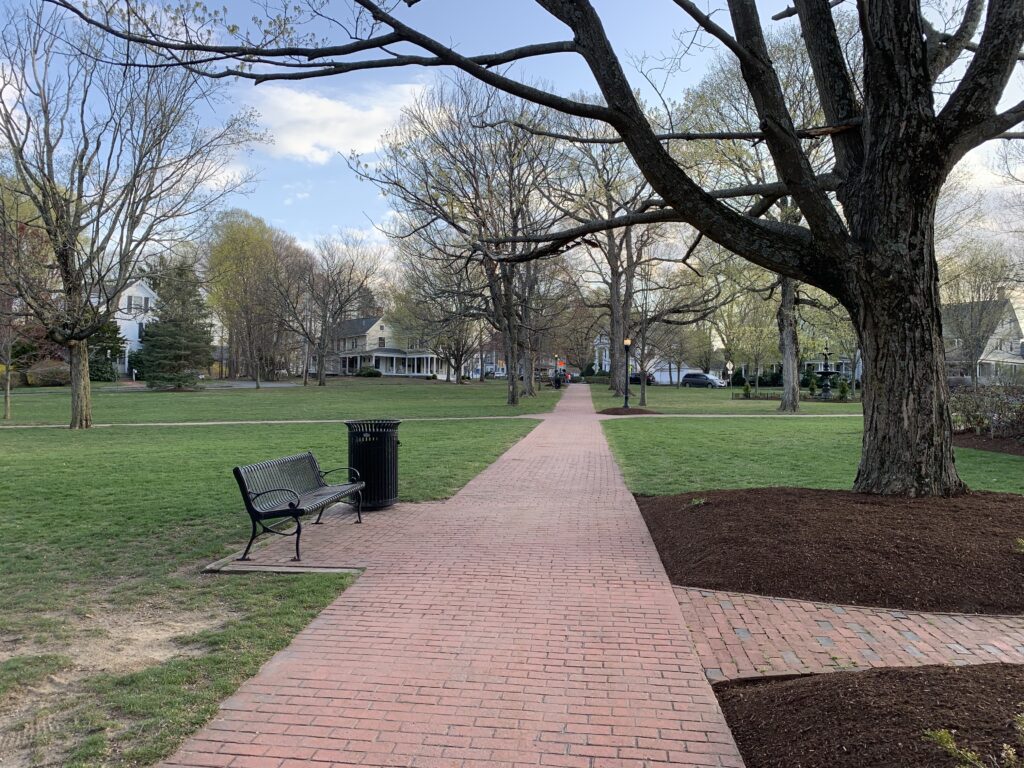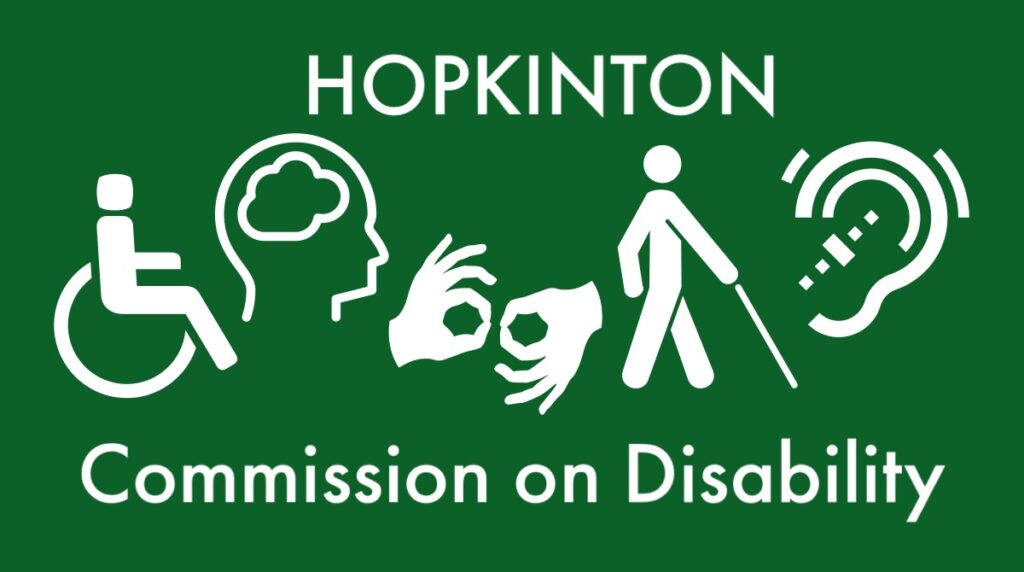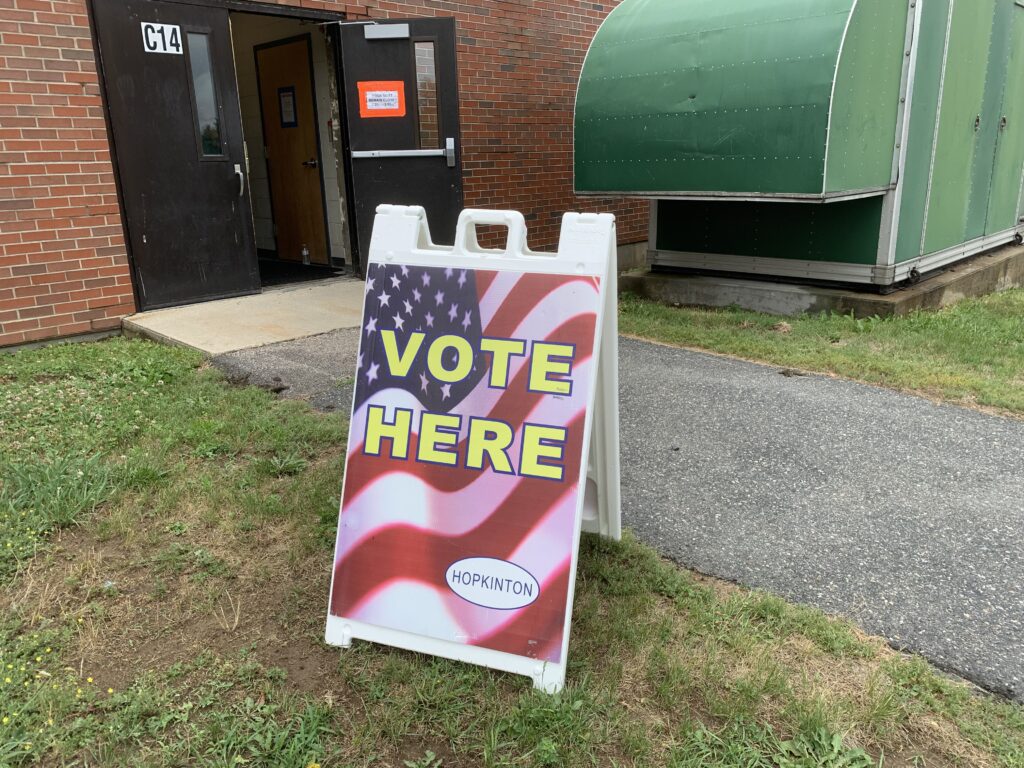The Disability Commission hosted a public forum Monday that allowed about 30 people to give feedback about Hopkinton’s accessibility challenges while acknowledging the growing understanding of the needs of members of the disability community.
Chair Holly Morand welcomed the audience by explaining the history of the fledgling commission. For the past several months, it has been seeking community input through a survey on areas of town that may be problematic for people with different types of challenges. While the seven-member commission serves in an advisory capacity to town government, Morand stressed that its effectiveness in prioritizing goals is strengthened by community engagement.
“Our specific priorities and actions depend upon the needs of this community,” said Morand. “Considerations run across the spectrum of disability, including physical/mobility, neurocognitive, mental health, auditory/speech and any other potential factors that make navigating community spaces difficult.”
Added Morand: “Conversations about inclusion and accessibility can be difficult, and I hope we can help our vulnerable friends and neighbors feel empowered to speak.”
Tax relief program assists people with disabilities, older residents
Hopkinton Tax Relief Committee chair Sue Kurys explained that information about the Senior and Disabled Tax Relief Fund recently was released by the town that could help homeowners with their property tax payment.
Applicants must be at least 60 years old or have a state-recognized disability, and they must own and occupy a single-family home in Hopkinton as their primary residence. Details are available on the town website.
The program is solely funded by contributions from taxpayers. Over the years, the committee has been able to provide applicants help from a pool of as much as $20,000 in donations.
Said Kurys: “What we haven’t been able to do is to reach out to homeowners who have a disability and may need assistance.”
While taxes have escalated in recent years, these residents remain on fixed incomes. Taxes can represent as much as 20% of their annual income, according to Kurys.
State Rep. James Arena-DeRosa noted that there is state legislation pending that will double the senior tax circuit breaker amount.
Schools are better at recognizing accessibility needs than town overall
While audience members raised ideas, commission and Select Board member Amy Ritterbusch took them down on sticky notes. They were placed on three easels. They respectively showed areas of success, difficulty and resources so the group could visualize their impact.
Hopkinton Public Schools Superintendent Carol Cavanaugh pointed out district programming to improve awareness and understanding around disability issues, highlighting the “Understanding Our Differences” program, among other efforts. Adding yellow tape to stairs helps those with visual impairments better navigate them.
Hopkinton Special Education Parent Advisory Council (SEPAC) chair Jen Halliday stressed that more needs to be done once students with disabilities age out of school programming at age 22 to have opportunities.
Said Halliday: “What are they supposed to do? Sit in their rooms and die?”
Others agreed that more needs to be done for adults with disabilities overall. Many don’t know of services available when they do exist.
Concerns with town sidewalks and properties were paramount. Morand described a complaint she received about the “crumbing” sidewalk on Walcott Street. Other sidewalks have been impacted by the Main Street Corridor Project.
On a positive note, Ritterbusch pointed out that having closed captioning for Annual Town Meeting was successful, as well as having documents available in large print. Commission member Nancy “Punky” Drawe added that having American Sign Language interpreters as well showed the town’s recognition of this need.
Fire Chief Gary Daugherty Jr. said he wished his department had more uninterrupted time for public safety training about the issues being raised. Having information in advance about potential health concerns exclusively available to public safety responders could make the difference in rescuing people with disabilities in an emergency.
Community meetings also need to better recognize the needs of people with disabilities. Several members mentioned poor sound quality. Morand pointed out that entities such as the Planning Board should provide more description of what they are speaking about rather than pointing to a drawing and saying, “It’s right there.”
More public seating at the Town Common would be helpful to accommodate people with disabilities who want to attend concerts and other community events.
Some accessible parking spaces in the downtown were removed, exacerbating challenges. Audience members asked for increased police enforcement of people who violate the usage policy for these spaces.
Commission member Praveen Hariharan asked Senior Services Director Amy Beck about exercise and nutrition awareness programs. He also asked if physical therapists could be involved and if mobility aides could be recommended for people, although these are typically prescribed or recommended by doctors. Beck described several exercise and engagement programs offered, including the “memory café” and yoga.
Outreach to businesses about accessibility concerns critical
Drawe stressed that many downtown businesses may consider themselves ADA compliant because they have an accessible parking space nearby or a ramp. But if there are no curb cuts, doors are heavy, thresholds are hard to maneuver, or customers need to climb a stair to get to a ramp, they are not accessible in reality.
“Getting into a store, if you use or a wheelchair or if you use mobility aids, in many places in town, you just can’t do it,” she stressed. “I want to be able to get a muffin or a slice of pizza, too.”
Ritterbusch suggested possibly giving awards to businesses that make efforts to be more inclusive. Commissioners joked that perhaps they could be called “Punky Approved.” Member Mike DiMascio said there is possible grant funding available for businesses willing to make modifications. Arena-DeRosa said he would look into those possibilities.
Someone pointed out accessible parking in the back of one business and that another business will bring an order outside if the customer calls. Commission vice chair Alex Danahy pointed out that attitude is part of the problem in overcoming the stigma associated with having a disability.
“It happens a lot with our society, and not even in this town, sadly,” said Danahy. There is a negative subliminal message if people with disabilities can only enter from the back of a building — if they can enter it at all.
More push buttons at doors would make this population feel welcomed, he added. At Town Hall, he said one time one push button was broken while the other was blocked by a table.
Danahy praised the Trails Committee for working with him to discuss trail accessibility. Morand mentioned that she works for Youth & Family Services, which is purchasing a portable ramp that can be used to access buildings.
Drawe and Danahy pointed out the long ramp into the library that has no hand rail, making it not truly accessible. Select Board member Mary Jo LaFreniere, who noted that she has had a mobility impairment for the past two years, said the hand rail was in the original plan but likely was scrapped because of building aesthetics.
For those whose disabilities are triggered by loud music and photosensitivity, Morand suggested a concept called “the purple table.” Special seating could be located in the rear of a restaurant where people could make reservations to sit in an area where they would not be stressed by over-stimulation.
The Commission on Disability is hoping to strengthen its relationship with the Hopkinton Chamber of Commerce to discuss improved access.
Town Clerk Connor Degan praised the commission for bringing to light “issues that not everyone is aware of” during the 90-minute forum.


















0 Comments